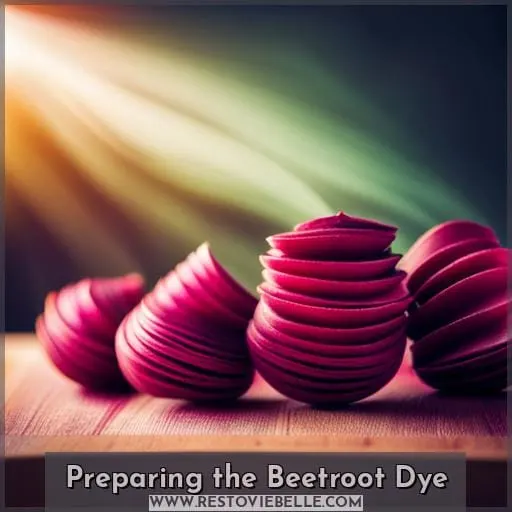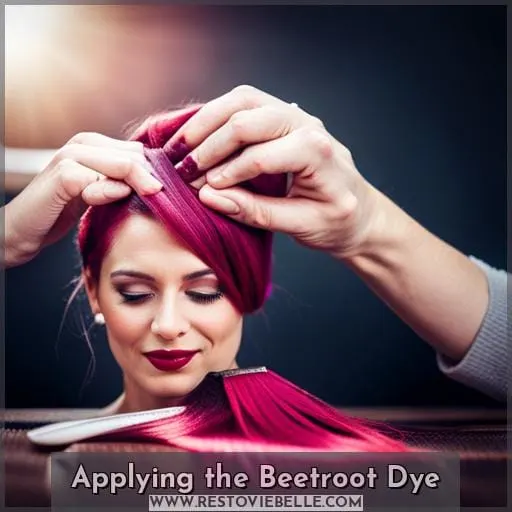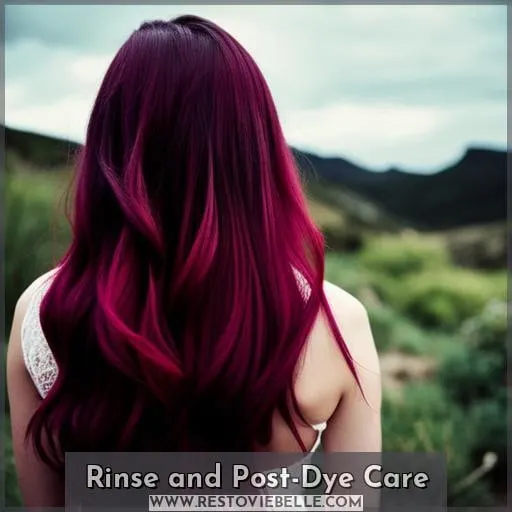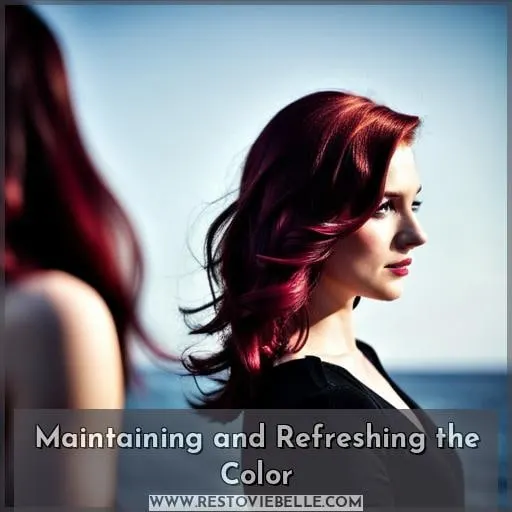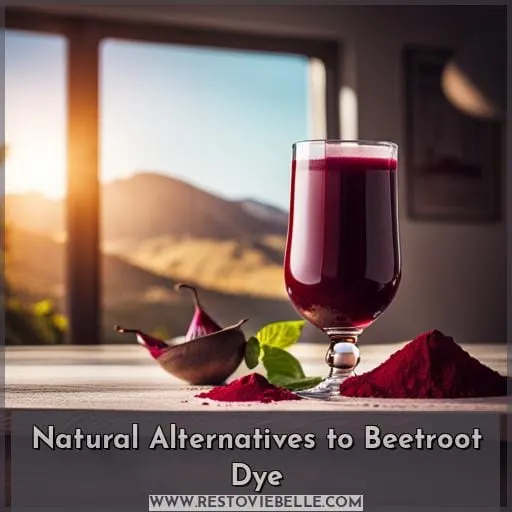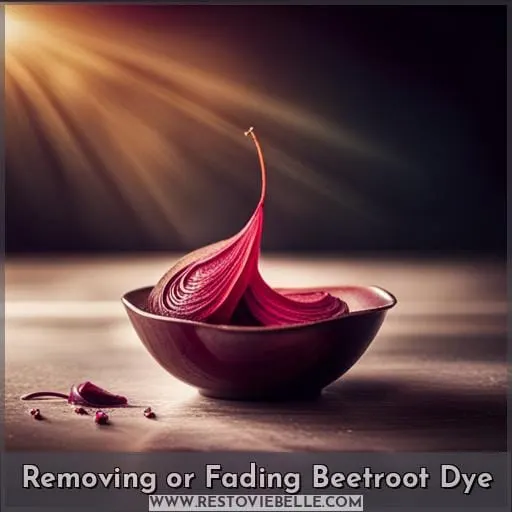This site is supported by our readers. We may earn a commission, at no cost to you, if you purchase through links.
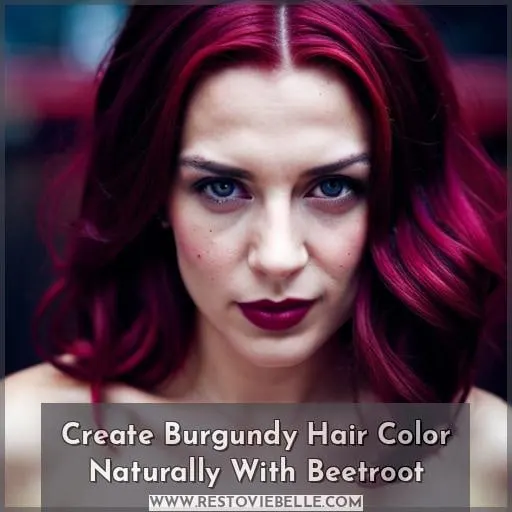 Imagine transforming your hair into a vibrant burgundy shade, all with the power of beetroot. Yes, you heard that right! This article will guide you through the process of creating burgundy hair color naturally using beetroot.
Imagine transforming your hair into a vibrant burgundy shade, all with the power of beetroot. Yes, you heard that right! This article will guide you through the process of creating burgundy hair color naturally using beetroot.
Say goodbye to chemical dyes and hello to a unique and healthy alternative for your locks. Get ready to unlock the secrets of DIY hair dyeing with this unconventional yet effective method.
Let’s dive in and discover how to achieve stunning burgundy tresses using nature’s own gift – beetroot!
Table Of Contents
- Key Takeaways
- Why Choose Beetroot for Burgundy Hair Color?
- Preparing the Beetroot Dye
- Patch Test and Skin Protection
- Applying the Beetroot Dye
- Rinse and Post-Dye Care
- Maintaining and Refreshing the Color
- Potential Challenges and Tips for Success
- Natural Alternatives to Beetroot Dye
- Removing or Fading Beetroot Dye
- Frequently Asked Questions (FAQs)
- Will the burgundy color from beetroot dye look natural?
- Is beetroot dye damaging for color-treated or previously bleached hair?
- How long does the beetroot color tend to last for dark brown hair compared to blonde hair?
- Can I use beetroot dye if I have an allergy to hair dyes or sensitive skin?
- What household items or surfaces might the beetroot dye stain, and how can I prevent or remove staining?
- Conclusion
Key Takeaways
- Obtain fresh beetroots or beetroot juice for dye extraction through juicing methods like baking, blending, and straining
- Mix beetroot juice dye with carrier oils and optionally hibiscus or rosemary for enhanced hair application and shine
- Section hair and evenly apply beetroot dye using a tinting brush or applicator for thorough coverage
- Preserve the burgundy color by rinsing with cold water, using color-safe products, minimizing heat styling, and limiting hair washing
Why Choose Beetroot for Burgundy Hair Color?
There are several reasons why you should choose beetroot for burgundy hair color.
Firstly, it offers a natural alternative to chemical hair dyes, which can be harsh and damaging to your hair.
Secondly, beetroot provides a vibrant and unique shade of burgundy that stands out from traditional dye options.
Lastly, there may also be potential health benefits for your hair when using beetroot as a dye due to its nourishing properties.
Natural Alternative to Chemical Hair Dyes
Choose beetroot as a natural alternative to chemical hair dyes for achieving a vibrant and unique burgundy shade.
By opting for DIY color with natural ingredients like beet juice, you can embrace sustainable beauty while taking care of your hair health.
Unlike harsh chemicals in traditional dyes, beetroot offers a holistic approach to beauty with its semi-permanent dye properties.
Say goodbye to harmful reactions and hello to beautiful, naturally colored locks!
Vibrant and Unique Burgundy Shade
To achieve a vibrant and unique burgundy shade for your hair, beetroot is an excellent choice due to its natural properties and rich pigment. Beetroot provides long-lasting color retention, allowing you to enjoy your burgundy hair for longer periods.
However, it’s important to be aware of potential beetroot allergies and the DIY challenges that may arise during the dyeing process. Additionally, seasonal variations in beet juice may affect the intensity of the color achieved.
To maintain your beautiful burgundy hue, follow proper maintenance tips such as using sulfate-free shampoo and minimizing heat styling tools.
Potential Hair Health Benefits
Enhance your hair’s health while achieving a vibrant and unique burgundy shade by incorporating beetroot into your natural hair dye routine.
Beetroot offers more than just color experimentation – it also provides nourishment for your hair. Packed with vitamins, minerals, and antioxidants, beetroot promotes healthy hair growth and strengthens the strands from within.
By opting for DIY beauty solutions like beet rouge, you not only get natural vibrancy but also sustainable alternatives that benefit both you and the environment.
Preparing the Beetroot Dye
To prepare the beetroot dye, you can either obtain fresh beetroots or use store-bought beetroot juice.
If using fresh beetroots, extract the juice by slicing them and blending them until smooth before straining out the liquid.
To enhance application and shine, mix the beetroot juice with a carrier oil such as coconut oil.
For desired results, consider adding other natural ingredients like hibiscus petals or rosemary for added depth and dimension to your burgundy hair color.
Obtain Fresh Beetroots or Beetroot Juice
To prepare the beetroot dye for creating burgundy hair color naturally, you’ll need to obtain:
- Fresh beetroots
- Beetroot juice
You can extract the juice by:
- Slicing and baking the beets
- Blending and straining them
Alternatively, you can use store-bought beetroot juice as a convenient option.
To enhance application and shine, mix the beetroot juice with a carrier oil like coconut oil.
Additionally, consider adding other natural ingredients for desired results in your DIY beauty routine such as:
- Henna benefits
- Preventing color fading
Extract Juice From Beetroots or Use Store-bought Juice
Now, let’s move on to extracting the juice from fresh beetroots or using store-bought beetroot juice to prepare your natural burgundy hair dye.
-
DIY Juicing Tips:
- Cut the beets into wedges and bake them before blending.
- Strain the blended mixture to extract the liquid for dyeing.
-
Color Intensity:
- The intensity of your burgundy shade depends on how much beet juice you use.
-
Stain Prevention:
- To prevent staining, wear gloves and an old T-shirt while handling beetroot.
-
Hair Health:
- Beetroot contains vitamins and antioxidants that can promote healthy hair during the dyeing process.
Mix Beetroot Juice With Carrier Oil for Better Application
Mix the beetroot juice with a carrier oil for a better application of the dye. This step is crucial to enhance color intensity and ensure even distribution on your hair.
Carrier oils like coconut oil or olive oil are great options due to their compatibility with beetroot juice. The carrier oil not only helps in easy application but also nourishes and moisturizes your hair during the dyeing process.
Additionally, it acts as a protective barrier against potential allergic reactions and stain prevention on your skin and clothes.
Consider Adding Other Natural Ingredients for Desired Results
For a more customized shade, you can enhance your beetroot dye by adding in other natural ingredients.
Natural enhancements such as henna, black tea, or coffee can be combined with beetroot to create unique ingredient combinations that result in enhanced color results.
These DIY hair blends have been used for centuries in historical cosmetics and provide not only beautiful color but also skin protection.
Hairdresser preparation often involves experimenting with different natural ingredients to achieve the desired burgundy hue.
Patch Test and Skin Protection
Before diving into dyeing your hair burgundy with beetroot, it’s important to conduct a patch test to check for any allergies or sensitivities.
Apply a small amount of the beet juice mixture on your inner arm and wait 24 hours to see if there are any adverse reactions.
To protect your skin from staining, apply petroleum jelly or a barrier cream around your hairline and ears before applying the dye.
Additionally, make sure to wear gloves and old clothing that you don’t mind getting stained during the application process.
Conduct a Patch Test to Check for Allergies or Sensitivities
Before applying the beetroot dye to your hair, conduct a patch test on a small area of skin to check for any allergies or sensitivities. This is important as some individuals may have adverse reactions to the natural ingredients in beetroot.
Apply a small amount of the dye mixture onto clean skin and leave it on for 24 hours. If there are no signs of redness, itching, or irritation, you can proceed with confidence knowing that you won’t experience any negative effects from using beetroot as a hair dye.
Protect Skin From Staining by Applying Petroleum Jelly or Barrier Cream
To protect your skin from staining during the hair dyeing process, apply petroleum jelly or a barrier cream.
This will act as a protective layer, preventing the beetroot dye from coming into direct contact with your skin and causing stains.
By using this simple technique, you can ensure that the color is evenly applied to your hair while keeping your skin stain-free.
Remember to conduct a patch test before applying any products to avoid potential allergic reactions or sensitivities.
Additionally, maintaining proper application techniques will help in achieving an even and long-lasting burgundy hair color.
Use Gloves and Old Clothing to Avoid Staining
To avoid staining your skin and clothes, make sure to wear gloves and old clothing when applying beetroot dye.
This will help prevent any unwanted color transfer onto your hands or garments. Additionally, using protective clothing allows you to freely apply the dye without worrying about potential stains or damage.
By taking these simple precautions, you can enjoy the process of creating burgundy hair color naturally while keeping yourself and your clothes stain-free.
- Wear gloves: Protects hands from getting stained by the beetroot dye.
- Use old clothing: Prevents staining on clothes that may be difficult or impossible to remove.
- Avoid unnecessary mess: Allows for a more relaxed application process without fear of ruining newer items in case of accidental spills or splatters.
Applying the Beetroot Dye
To apply the beetroot dye to your hair, start by sectioning your hair for easier application.
Use a brush or applicator to evenly distribute the dye throughout your hair, making sure to comb through it afterwards for thorough coverage.
Allow the dye to sit on your hair for the recommended amount of time before rinsing it out with cold water.
Section Your Hair for Easier Application
To make the application process easier, start by sectioning your hair. This will ensure that the beetroot dye is applied evenly and thoroughly throughout your hair. Sectioning also allows you to control the color intensity in different areas of your head, creating a more customized look.
By using proper application techniques and natural additives like coconut oil or carrier oils, you can achieve a vibrant burgundy shade that suits your style.
Apply the Beetroot Dye Evenly Using a Brush or Applicator
To ensure an even application, gently brush or carefully apply the beetroot dye using a brush or applicator throughout your hair. This will help distribute the color evenly and prevent patchiness. Pay attention to areas that are harder to reach, such as the back of your head or near the roots.
Using precise brush techniques will also allow you to control the color intensity for a customized burgundy shade. Remember to protect your skin with petroleum jelly and wear old clothing to prevent staining.
- Use long sweeping motions while applying the dye.
- Start from the ends of your hair and work towards the roots.
- Comb through each section after applying for thorough coverage.
Applying Beet Dye Evenly:
To ensure an even application, gently brush or carefully apply beetroot dye throughout your hair using a suitable tool like a dedicated hair coloring brush or applicator bottle with nozzle tip attachment.
This method helps distribute color uniformly across all strands while minimizing potential staining on other parts of scalp/face/body during application process itself—key step in achieving satisfactory results without unwanted streaks/patches!
Remember: precision is important when it comes down not only how much product gets onto individual hairs but also their exact placement relative one another within desired style/final look being cultivated by user (i.e., application precision).
Some common challenges faced by users may include:
- Color intensity variation
- Staining prevention
- Difficulties reaching certain areas (e.g., back)
By following proper brushing techniques along with recommended tips/tricks provided below under ‘Dyeing Challenges’, you’ll be able overcome these obstacles successfully!
Comb Through Hair to Ensure Thorough Coverage
After applying the beetroot dye evenly using a brush or applicator, comb through your hair to ensure thorough coverage. This step is crucial for achieving consistent color intensity throughout your locks.
By combing the dye from root to tip, you can distribute it evenly and reach every strand of hair. This technique helps in maximizing the effectiveness of the beetroot dye and ensures that each section is adequately saturated with color.
Additionally, combing through your hair also promotes better absorption and adherence of the natural pigment to achieve long-lasting results.
Allow the Dye to Sit for the Recommended Time
Now, let the beetroot dye work its magic by allowing it to sit on your hair for the recommended time. This waiting period is crucial for achieving vibrant burgundy color. Factors such as hair type and desired intensity may affect the duration, but typically leaving the dye on for at least 1 hour is recommended.
During this time, make sure to comb through your hair to ensure even coverage.
Once you’ve reached the desired wait time, rinse your hair with cold water to seal in the color and prevent fading.
Rinse and Post-Dye Care
To maintain the vibrant burgundy shade achieved with beetroot dye, it’s important to:
- Rinse your hair with cold water instead of hot water.
- Avoid using shampoo immediately after dyeing as it can strip away some of the color.
- Opt for a color-safe conditioner that will help preserve and enhance the burgundy hue.
- Protect your hair from sun exposure and minimize heat styling to prevent fading and maintain the desired shade for longer periods of time.
Rinse Hair With Cold Water to Preserve the Color
Maintain the vibrancy of your burgundy hair color by rinsing with cold water.
Cold water helps to seal the cuticles and preserve the color for longer periods. It also prevents fading and maintains a fresh, vibrant hue.
Post-dye care is essential in ensuring that your chosen shade stays true to its original intensity. Be aware of potential challenges such as color fading and explore natural alternatives for refreshing your hue if needed.
Avoid Using Shampoo Immediately After Dyeing
To preserve the vibrant burgundy color of your hair, it’s important to refrain from using shampoo immediately after dyeing.
Shampoo can strip away the natural oils that help seal in the color and cause premature fading.
Instead, rinse your hair with cold water to remove any excess dye without compromising its intensity.
After rinsing, use a color-safe conditioner to maintain the rich burgundy shade and protect against damage.
Consider natural alternatives like beetroot for long-lasting color maintenance without harsh chemicals or sulfates.
Use a Color-safe Conditioner to Maintain the Burgundy Shade
After rinsing out the beetroot dye, ensure that your burgundy shade stays vibrant and long-lasting by using a color-safe conditioner.
Color protection tips are crucial in maintaining DIY hair care results. Natural dyeing challenges may arise, but with proper post-dye care, you can enjoy beautifully styled burgundy hair for longer periods.
A color-safe conditioner will help preserve the intensity of the beetroot hue while nourishing and hydrating your locks.
Protect Hair From Sun Exposure and Heat Styling to Prevent Fading
Protect your hair from sun exposure and heat styling to prevent the burgundy color from fading.
Here are some tips for preserving the longevity of your vibrant hue:
- Shield your hair with a hat or scarf when out in the sun.
- Use heat protectant sprays before using hot tools like curling irons or straighteners.
- Avoid excessive use of blow dryers, as they can contribute to faster fading.
- Opt for hairstyles that minimize direct sunlight on your colored strands.
- Consider using UV protection products specifically designed for colored hair.
Maintaining and Refreshing the Color
To maintain and refresh your burgundy hair color created with beetroot, it’s important to:
- Limit hair washing in order to prolong the longevity of the color.
- Consider using color-depositing products or natural rinses that can help refresh and enhance the hue.
- Avoid exposing your colored hair to chlorine or saltwater as they can fade the vibrant burgundy shade.
- Schedule regular touch-ups to maintain the desired intensity and vibrancy of your burgundy hair color.
Limit Hair Washing to Prolong the Color’s Longevity
To prolong the longevity of your burgundy hair color, limit washing it as much as possible.
Washing frequency plays a crucial role in preserving the vibrancy of the color. Over-washing can cause premature fading and dullness.
Instead, opt for dry shampoos or gentle cleansing methods to keep your hair clean without stripping away the color.
Additionally, minimize exposure to sunlight as it can also contribute to color fading over time.
Use Color-depositing Products or Natural Rinses to Refresh the Hue
Preserve your beetroot burgundy hair color by using color-depositing conditioners or applying homemade natural rinses weekly. These products help maintain the vibrancy of your hue and prevent fading over time.
Color maintenance is key to keeping your burgundy shade looking fresh and vibrant for longer periods. DIY refreshers are a great way to touch up any areas that may have faded, while also providing additional nourishment to your hair.
Additionally, these natural alternatives minimize the risk of allergic reactions and offer skin protection compared to traditional chemical dyes.
Avoid Chlorine and Saltwater, as They Can Fade the Color
When maintaining and refreshing the burgundy hair color created with beetroot, it’s important to be mindful of avoiding exposure to chlorine and saltwater as they can cause the color to fade. Wear a swim cap when swimming and rinse hair with cool water after to remove chlorine residue.
Use DIY hair masks between colorings and explore fun color-blocking styles that incorporate the burgundy hue into your hair care routine.
Schedule Regular Touch-ups to Maintain the Desired Burgundy Shade
To maintain and refresh your desired burgundy shade, it’s vital to schedule regular touch-ups every 4-6 weeks. This maintains consistent color intensity and prevents excessive fading between applications.
While DIY dyeing can be challenging, consider supplements like color-depositing conditioners or henna gloss treatments to preserve the shade between full dye sessions.
Exploring various natural dye components can also help refresh the burgundy tone as needed.
Potential Challenges and Tips for Success
When attempting to dye your hair burgundy with beetroot, it’s important to be aware of potential challenges and tips for success.
One challenge is that beetroot dye may not work well on all hair types or colors, so lightening or bleaching the hair beforehand may be necessary for better color payoff.
Additionally, experimenting with different ratios and mixtures of beet juice can help achieve the desired intensity of burgundy.
If you’re unsure about the dyeing process, seeking professional advice can provide guidance and ensure a successful outcome.
Beetroot Dye May Not Work Well on All Hair Types or Colors
If you have naturally light or blonde hair, beetroot dye may not work as well to achieve the desired burgundy color.
Here are some potential challenges and tips for success with beetroot dye:
- Color intensity: Lighter hair colors may result in a more subtle tint.
- Sensitivity concerns: Conduct a patch test to check for any allergies or sensitivities.
- Customization options: Experiment with different ratios and mixtures for desired intensity.
- Professional consultation: Seek advice from a holistic cosmetologist if unsure about the process.
Remember that individual results may vary, so it’s always best to consult professionals before attempting any major changes on your own.
Lightening or Bleaching May Be Necessary for Better Color Payoff
Although beetroot dye may not work well on all hair types, you’ll likely need to lighten or bleach your hair first for the burgundy color to show up properly. This preparatory color correction opens the hair cuticle, allowing the dye to deposit more vibrantly.
However, take care not to over-process hair when pre-lightening to avoid damage.
Alternatively, try burgundy henna or black tea rinses for gentler options before committing to bleach. These natural alternatives still deposit color, while supporting hair health through conditioning properties.
Follow up with protective measures like oils, limiting heat styling, and wearing hats outside.
Experiment With Different Ratios and Mixtures for Desired Intensity
Now, it’s time to play around with different ratios and mixtures to achieve your desired intensity of burgundy hair color.
Adjusting the amount of beetroot juice or carrier oil can affect the color intensity. Keep in mind that ingredient variations may result in varying shades of burgundy.
It’s important to be cautious about allergic reactions and conduct a patch test before applying the dye mixture. Additionally, styling challenges such as avoiding heat tools should be considered for maintaining longevity and vibrancy of the color.
Seek Professional Advice if Unsure About the Dyeing Process
When unsure about the dyeing process, consider seeking professional advice to navigate potential challenges and ensure success.
Consult a stylist to assess your hair type’s suitability, customize the dye ingredients for you, and guide proper technique.
Professionals can also advise on conducting patch tests to check for allergies, using stain removers if needed, and experimenting with natural ingredient ratios to achieve your ideal shade.
Their expertise allows creating your custom DIY natural hair color while avoiding mistakes.
Natural Alternatives to Beetroot Dye
If you’re looking for alternatives to beetroot dye, there are several natural ingredients that can help achieve a burgundy hair color.
Henna is a popular option, offering vibrant and long-lasting results.
Black tea and coffee can also darken the hair naturally, providing subtle shades of burgundy.
Consider the pros and cons of each alternative before making your choice for a natural hair dye solution.
Explore Other Natural Ingredients for Burgundy Hair Color
You can also get similar burgundy shades using henna, black tea, or coffee as alternatives.
- Henna offers a vibrant, long-lasting plant-based burgundy dye.
- Black tea provides subtle wine undertones when used as a hair rinse.
- Used coffee grounds can enhance brown hair with rich auburn hues.
Test alternates first to find the right match for your hair color and goals.
Henna, Black Tea, and Coffee Are Popular Alternatives
Consider henna, black tea, and coffee as popular alternatives to beetroot dye for achieving burgundy hair color naturally.
Henna offers longer-lasting color results and conditioning benefits.
Black tea infusions gradually build rich warmth.
Coffee can enhance depth in brunette shades.
However, test any natural dye option for allergic reactions first.
Maintain color vibrancy between applications by limiting washing, heat tools, and sun exposure.
Although natural, these organic dyes still carry risks like skin irritation.
Seek professional guidance to find your best burgundy hue safely.
Consider the Pros and Cons of Each Option Before Choosing
Before deciding on a natural alternative for achieving burgundy hair color, it’s important to weigh the pros and cons of each option.
Consider:
- Ingredient comparisons
- Application techniques
- Allergy considerations
- Color maintenance
- Seek professional advice
Different alternatives such as carrot juice or henna may have varying effects on different hair types and colors. It’s essential to understand the potential benefits and drawbacks of each choice before making a decision.
Removing or Fading Beetroot Dye
As the beetroot dye begins to fade from your hair naturally over a few weeks, you may wish to speed up the process.
Using a clarifying shampoo or vitamin C treatments can help remove more of the color quickly.
For complete dye removal, you’ll likely need to seek professional help from a colorist.
Beetroot Dye is Likely to Fade Naturally Over Time
With you, beetroot dye will fade naturally over weeks since it’s temporary. The fading process varies for each individual and can be influenced by factors such as hair porosity, color intensity, and maintenance routine.
On average, the burgundy hue created with beetroot dye may last anywhere from 1 to 4 weeks before gradually fading away.
To refresh the color or maintain its vibrancy, consider using natural rinses or color-depositing products made with ingredients like hibiscus or cranberry juice.
| Fade Timeframes | Color Refresh | Allergic Reactions | Root Touch-ups |
|---|---|---|---|
| [1-4 weeks] | [Natural Rinses] | [Patch Test] | [As needed] |
Table: Tips to Manage Beetroot Dye Fading Naturally
Use Clarifying Shampoo or Vitamin C Treatments to Speed Up Fading
You can use clarifying shampoo or vitamin C treatments to speed up the fading if you want to remove the beetroot dye more quickly.
Clarifying shampoos help strip the cuticle of residue and fade dye faster.
Mix crushed vitamin C tablets into your shampoo to accelerate fading – the acidity removes artificial pigment.
Wear stain-resistant clothing after dyeing since beet juice may still rub off.
While convenient and fun, beetroot dye is temporary – not a permanent solution. Adjust your aftercare routine if you want the color gone fast.
Seek Professional Assistance if the Dye Needs to Be Completely Removed
Although you may want to remove the dye yourself, seek professional help if it needs complete removing.
- Get an allergy test
- Use barrier creams during removal
- Section hair for easier application
- Employ color-safe products
- Check if lightening/bleaching is required
- Ensure thorough removal without damage
Frequently Asked Questions (FAQs)
Will the burgundy color from beetroot dye look natural?
Unfortunately, beetroot dye typically doesn’t produce a natural-looking burgundy hair color.
While it may tint hair a subtle reddish or purple hue temporarily, the results are quite unnatural and unrealistic for achieving a true burgundy shade.
I’d recommend exploring semi-permanent burgundy hair dyes from trusted brands instead.
Is beetroot dye damaging for color-treated or previously bleached hair?
Beetroot dye is unlikely to damage color-treated or bleached hair when used correctly. However, consult your stylist first, as overprocessed hair may be more vulnerable.
Apply beet juice carefully, leave on no longer than an hour, and rinse thoroughly with cool water.
How long does the beetroot color tend to last for dark brown hair compared to blonde hair?
The beetroot color will typically last longer (around 1-2 weeks) on darker brown hair compared to blonde hair (5-7 days). This is because the pigments bind more easily to darker hair, while lighter hair lacks enough underlying pigment for the dye to adhere to as strongly.
Can I use beetroot dye if I have an allergy to hair dyes or sensitive skin?
If you have an allergy to hair dyes or sensitive skin, using beetroot dye may be a safer alternative. Its natural properties can reduce the risk of adverse reactions and provide a liberating experience in achieving your desired burgundy color.
What household items or surfaces might the beetroot dye stain, and how can I prevent or remove staining?
Beetroot dye can stain skin, towels, sinks, bathtubs, and counters.
To minimize staining, cover surfaces with plastic sheets or trash bags.
If stains occur, scrub promptly with baking soda paste or undiluted white vinegar.
Cold water washing helps preserve color while minimizing transfer to unintended surfaces.
Conclusion
To achieve stunning burgundy hair color naturally, beetroot is your secret weapon. This unconventional yet effective method offers a vibrant and unique shade while avoiding harmful chemicals.
By preparing the beetroot dye, conducting patch tests, and applying the dye evenly, you can achieve beautiful results.
While beetroot dye may not work for everyone, there are other natural alternatives to explore. Embrace the power of beetroot and transform your hair into a gorgeous burgundy hue.

